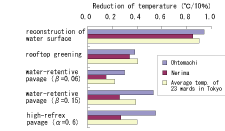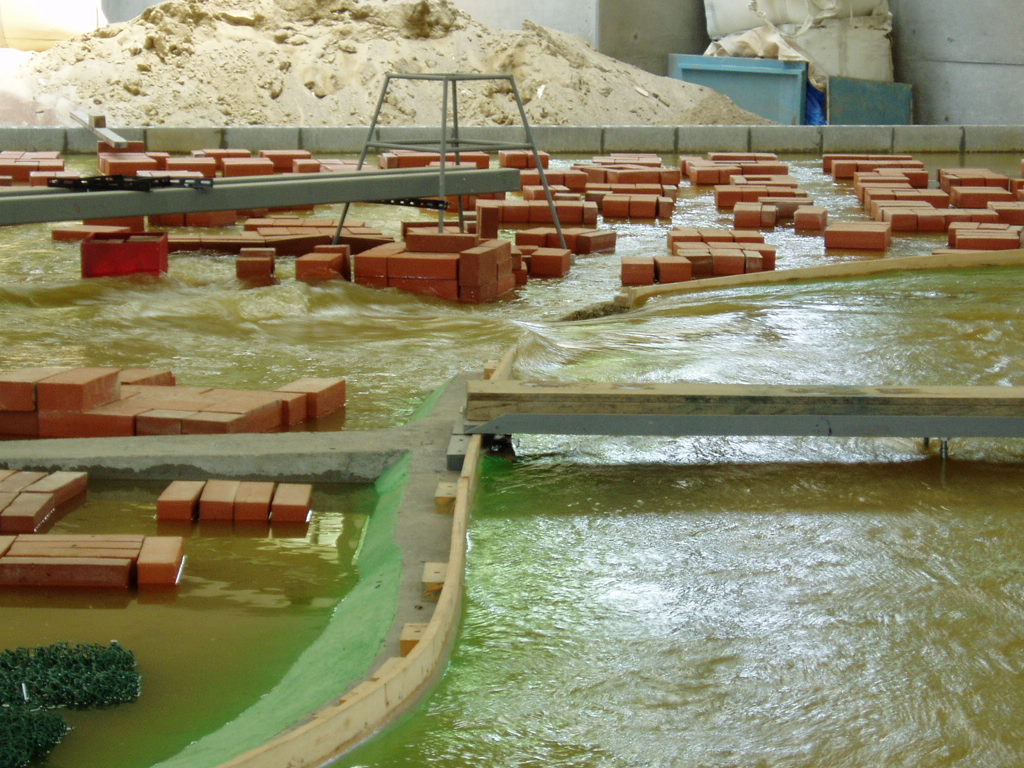
|
Newsletter from the Secretariat for Preparatory Activities of UNESCO-PWRI Centre (ICHARM) Issue No.6 July 2005
| |||
In this sixth issue of our periodical newsletter we continue our focus on providing our national and international partners and colleagues with up-to-date information on the progress of the preparatory work toward the establishment of ICHARM (International Centre for Water Hazard and Risk Management) under the auspices of UNESCO in fiscal year 2005. | |||
| What's in this issue
| |||
|
1. Message from the Director of the Secretariat | |||
| The participants from the Netherlands and Japan exchanged views on a wide range of subjects of their mutual interest in the field of integrated water management at the Symposium in June organized by Japan Ministry of Land, Infrastructure and Transport and the Netherlands Ministry of Transport, Public Works and Water Management. It was a good opportunity for both countries to reconfirm the importance of mutual cooperation in the field of 'water', for example by cooperatively preparing a vision document with shared lessons and challenges in integrated water management to be jointly presented at the 4th World Water Forum in Mexico, March 2006. The aim of setting up ICHARM also lies in forming an international solidarity through 'water', by promoting collaborative approach in preventing or mitigating water related disasters from global perspective. PWRI is now internationally seeking a full time researcher working for ICHARM. This is the first experience of international recruitment for PWRI, which is planned to be followed by 2nd and 3rd recruitment for the researcher positions for water related disaster risk assessment, disaster management measures, collecting and disseminating information and hydrological analysis etc. It would be greatly appreciated if you kindly distribute the recruitment information to the possible candidates who might have interest in applying. ( ☞ Click here for recruitment information) | |||
|
Akira TWRAKAWA Director of the Secretariat  | |||
|
2. Recent Topics | |||
| i. Exhibition of ICHARM at the UN Pavilion at the Expo 2005 Aichi ICHARM is currently hosting an exhibition in the Expo 2005 Aichi, which extends March 25, 2005, to September 25 in Aichi Prefecture, Japan. ICHARM shares the UN Pavilion with other countries and organizations, exhibiting panels that introduce its various activities. The ICHARM exhibition opened on July 3rd and continues till August 5th at the Education Center in the UN Pavilion. At the exhibition site, visitors can learn about ICHARM from the panels under the theme of "To Prevent and Mitigate Water-related Disasters in the World." The panels explain the purposes, history and activities of ICHARM inexplanations written simple enough for the general public, including children and students, to understand. ICHARM's brochures are also available at the site. The UN Pavilion is in Global Common 2, which is a section of the Nagakute Area. If you take a liniear motor train, which runs from the Fujigaoka Station (Nagoya City Subway) to the Expo Yakusa Station (Aichi Kanjou Railway), you can get off at the Expo Venue Station. In front of the station is the north gate of the Nagakute Area. It takes about five minutes to get to the UN Pavilion from the gate. For more details, please visit the Expo website. | |||
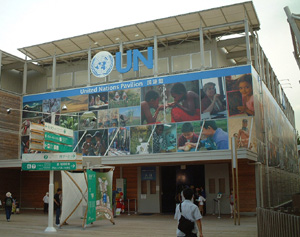 The entrance of the UN Pavilion | 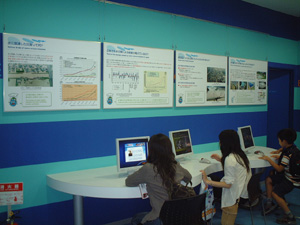 Panel display in the UN Pavilion | ||
| ii. Lecture on climate change, flood protection and river rehabilitation by Prof. Coops On June 28, we invited Professor Hugo Coops to deliver a lecture entitled "Climate change, flood protection and rehabilitation along the River Rhine." The professor is presently a senior aquatic ecologist at the Institute for Inland Water Management and Waste Water Treatment in the Netherlands, and is a guest professor at the Research Center for Coastal Lagoon Environments, Shimane University. At the beginning of the lecture, Prof. Coops briefed the audience on the history of river improvement in the River Rhine as well as on environmental issues related to the river. According to him, during the 1970s and 1980s, the environment in the River Rhine deteriorated dramatically and was called "the sewer of Europe". However, "Rhine Action Programme," "Living Rivers" and other measures successfully rehabilitated the once-deteriorated environment. This example shows that the preservation of the river environment is an inevitable issue when developing a river. Prof. Coops then explained the effect of climate change on the river discharge and water level of the North Sea. There are a number of different global warming scenarios, and some of them predict that the January river discharge in the River Rhine would increase by 20 percent due to melting glaciers and other relevant factors if the annual mean temperature goes up by 2 degrees Celsius by the end of this century. The sea level would also rise by more than 20 cm. He introduced "Grensmaas-project," "Room for River" and "EU Water Framework Directive" as examples of water policies in Europe that have taken those climate changes into account. The professor also mentioned the case of the Haringvliet Dam, which was constructed in 1971 at the estuary of the River Rhine. The dam contained sluice gates that were closed most of the time and opened only under certain conditions. The initial objectives of the dam were to prevent floods, to secure drinking and agricultural water by avoiding salinization of the river water, and to keep the water level deep enough for river navigation. However, the construction and operation of the dam resulted in a number of negative ecological effects, and public interest in the restoration of the lost brackish-water region grew stronger and stronger. Eventually, the government decided that about one-third of all the sluice gates should be kept open at up to 95 percent of the high tide level. When the sea level exceeds the 95 percent level, all the sluice gates are closed and the dam acts as a storm surge barrier. ICHARM is going to make comparative study on various water related disasters in river basins around the world and solutions for them, which would be effective for ICHARM to meet these expectations, this kind of lectures and important to form a solid foundation for future studies. For this purpose ICHARM will invite eminent researchers at home and abroad. | |||
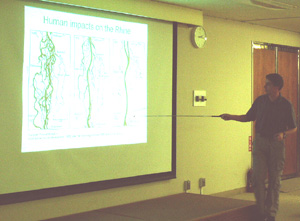 A scene from the lecture | 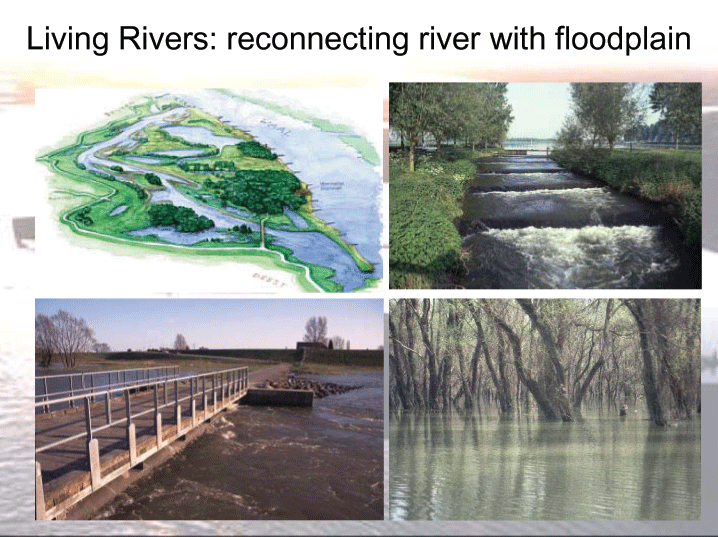 A slide from the presentation | ||
| 3. Research Activities | |||
| i. Measures for the mitigation of the heat island phenomena in urban areas and an evaluation method for those measures Dr. Yoshiko
IIZUMI, Researcher, Hydrologic Engineering Research Team
The heat island phenomenon has become an increasingly serious problem in urban areas in summer. It is widely known that the phenomenon is caused by overpopulation, huge energy consumption, and a decrease in tree coverage and water surface. To mitigate the phenomenon, PWRI has developed a simulation technique to evaluate the effect of various countermeasures to the heat island phenomenon, in terms of how effectively they lower atmospheric temperature and reduce energy consumption. Using the simulation to evaluate the cost-effectiveness analysis of different countermeasures, PWRI has made the following two approaches: 1. Simulation technique of the heat island phenomenon and the effect of countermeasures to mitigate the phenomena at urban areas PWRI has developed a new simulation model to evaluate heat island countermeasures for their effectiveness, based on the simulation model called MM5, which is provided free by the National Center for Atmospheric Research (NCAR). The new simulation system reproduces the spatial and temporal distribution of atmospheric temperatures, humidity and wind speed in fair weather in the Tokyo metropolitan area, and calculates the effectiveness of countermeasures, using altitude, land use, and heat emission by human activity in the area. The figure below shows how effectively different measures work to lower temperatures. When applied to ten percent of the whole target area, the reconstruction of water surface is the most effective countermeasure in decreasing atmospheric temperatures during daytime. 2. Clarification of the cost-effectiveness of various countermeasures To clarify the cost-effectiveness of different countermeasures when they are employed on a large scale, the following three factors are considered: the effectiveness of each measure in lowering temperature, the total cost (C: cost) to carry out each measure (including the initial cost and maintenance cost), and the accompanying benefits (B: benefit). The target countermeasures are 1) restoration and preservation of the natural environment (such as reconstruction of water surface), 2) improvement in heat response of artificial coverings (such as pavage), 3) reduction of heat emissions from human activities. The B/C ratio estimated by results of cost-benefit analysis has indicated that ground greening and reduction of domestic heat emissions are the most effective measures. However, results may be affected by various factors under different conditions. | |||
|
4. Reports on Recent Conferences Attended | |||
| i. The Workshop on Effective Typhoon Forecasts and Warnings sponsored by Typhoon Committee, ESCAP/WMO From 24th to 28th April, the Workshop on Effective Typhoon Forecasts and Warnings was held in Shanghai, China. This workshop was sponsored by the Typhoon Committee, and it brought together a large number of meteorologists and other experts in related areas from Asia-Pcific countries suffered from typhoons. Mr. Fukami, team leader of the Hydrologic Engineering Research Team, was invited to the workshop as expert on flood countermeasures, and delivered a presentation entitled "Flood Risk Management: Significance of Synthetic Approach" in the session of the impact of disaster and analysis of vulnerability. In the presentation, he pointed out the ideal state of a flood risk management cycle and social and economical obstacles against the cycle, such as poverty. He also explained a historical shift from structural-centered measures to comprehensive measures to cope with urban flood more effectively. He ended his presentation, emphasizing the importance of the balance between the two measures in terms of flood prevention. Other sessions included "the accuracy and reliability of weather forecasts", "the ideal conditions to announce forecasts and warnings", and "public education and dissemination." At the end of the workshop, the report was compiled after the general discussion. Even though the technology for typhoon forecasts has been rapidly progressing, there is still room for further improvement from the viewpoint of flood and erosion control. It is necessary for experts on hydrology to undertake elaborate discussions with experts on meteorology about the ideal conditions for flood forecasts. | |||
| ii. The 5th Science Council of Asia (SCA) Conference 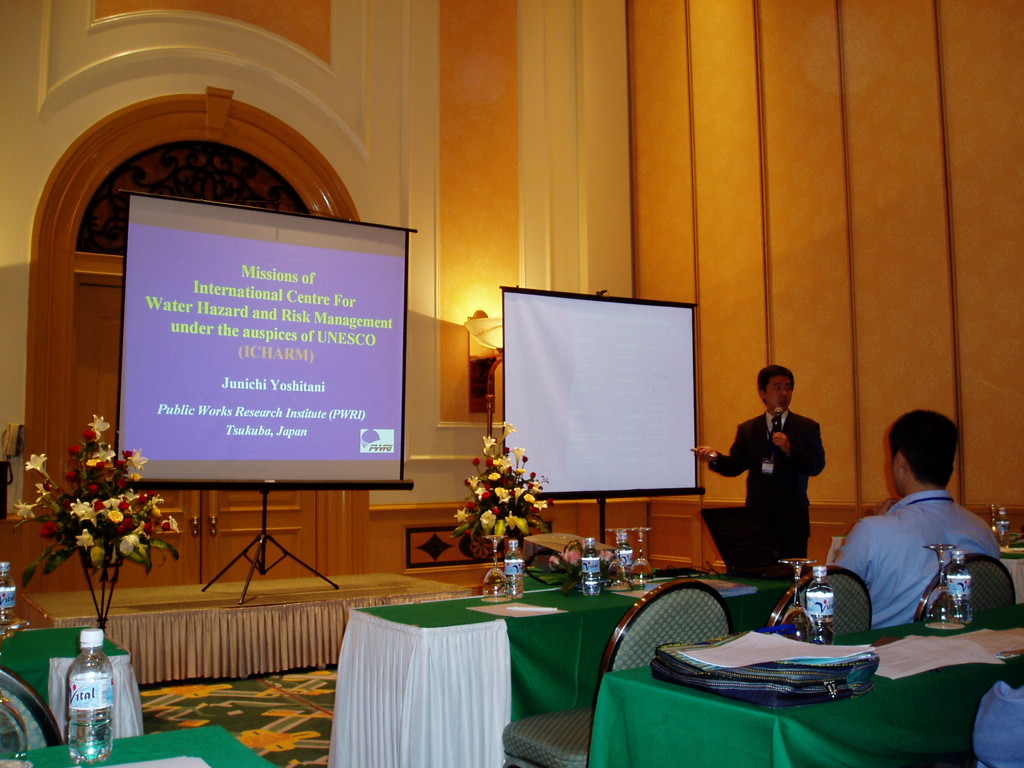
Messrs. Shigenobu Tanaka and Junichi Yoshitani participated in "The SCA Joint Project Workshop on Collaborative Research in the Field of Hydrology: Recent Developments of Water Resources and Hydrology" in the 5th Science Council of Asia Conference in Hanoi, Vietnam from May 11 to 13, 2005. This workshop was organized by Prof. Tadashi Yamada, Chuo University, Japan. It focused on computer software tools for helping solve water resource problems. Eight papers were presented, covering different aspects of the development and use of computer software related to water issues. Using computer models has become an important component of hydrological research, capacity building and promoting community participation in decision-making. The participants agreed that it is important for the region to foster communication and peer-support in the area of water modeling in the region. Mr. Yoshitani made a presentation on successful and unsuccessful examples of model applications and preparatory activities of ICHARM. | |||
| iii. Japan-Netherlands Symposium on integrated water management Japan-Netherlands Symposium on integrated water management was held in Tokyo on June 8. The Netherlands delegation was headed by Ms. Melanie Schultz van Haegen, Senior vice Minister of the Ministry of Transport, Public Works and Water Management. The Japan delegation was headed by Mr. Minoru Hasumi, vice Minister of the Ministry of Land, Infrastructure and Transport. From each country more than 30 members attended the conference. Mr. Terakawa, Director of the Secretariat, participated as one of the Japanese delegation and made a presentation entitled 'Public Private Partnership - Collaborative Approach in Research Activities' in the session to discuss the institutional aspects. He explained the PWRI framework of joint research projects with private companies, research collaboration with foreign research institutes and also briefly introduced the preparatory activities to set up ICHARM, which also intends to promote research cooperation with related public and private organizations. In the summarizing session,Vice Ministers from both countries signed on the Declaration of Intent concerning co-operation in the field of integrated water management', in which it was agreed to stimulate a mutual exchange of knowledge and strengthen their cooperation, with the aim of strengthening a knowledge base for the formulation and implementation of national water policies. On the next day of the Symposium, 14 Dutch members headed by Ms. Van der Hee, Managing Director of the National Institute for Coastal and Marine management, visited NILIM (National Institute of Land and Infrastructure Management) and PWRI (Public Works Research Institute) in Tsukuba. They made a tour for experimental facilities and also exchanged information with the Japanese participants from both institutes on the management aspects of the research institutes and on the present situation to cope with water related problems. | |||
|
iv. Acid Rain 2005 7th International Conference on Acid Deposition Acid Rain 2005 (http://www.acidrain2005.cz/), an international conference on acid deposition, was held in Prague, Czech Republic from 12 to 17 June 2005. A total of 650 oral or poster presentations were made at the conference. Reported research results varied from global emission of air pollutants, long-range transport models of air pollutants, ecosystems, to other relevant issues. In this conference, Dr. Iizumi, researcher of the Hydrologic Engineering Team, made a presentation entitled "Chemical characteristics of stream water and material balance at a forested catchment in Tokyo, Japan." In this presentation, she clearly explained the actual material balance, including precipitation, at the tributary basins of the Tamagawa River in Tokyo, showing the observation data during the flood and normal times. | |||
| v. Asia Oceania Geosciences
Society (AOGS) 2nd Annual Meeting 2005 The Asia Oceania Genosciences Society Second Annual Meeting was held in Singapore from June 20 through 24. Mr. Tebakari, project research fellow of the Risk Management Research Team, participated in "Hydrological Science", one of the five principal categories in the meeting. In the Hydrological Science category, the researcher made a presentation entitled "Impact of large-scale reservoirs development on hydrological regime in the Chao Phray River basin, Kingdom of Thailand". After the presentation, he was given an opportunity to exchange meaningful opinions and comments with the audience. | |||
|
vi. The 28th Japan-Korea Joint Meeting on River and Water Resources Development
From 3rd to 10th July, the 28th Japan-Korea Joint Meeting on River and Water Resources Development was held in Korea. Mr. Tanaka of the Secretariat joined the Japanese delegation, which is consisted of 12 members, headed by Mr. Tsuchiya, Vice-Director of the River Bureau, while Korea sent 13 members, with Dr. Chum, Director General of the Water Resources Bureau, Ministry of Construction and Transportation, as head of the group. Since the establishement based on the joint statement of the 1977 Japan-Korea Ministerial Meeting on Science and Technology, this annual meeting has been alternately held in Japan and Korea. The meeting has since served as a place to present research results on the technical issues of river and water resources development, exchange views, and promote technical cooperation between the two countries. This year, there were presentations and discussions on three common themes to the countries, which were 1) flood risk management, 2) river improvement incorporating land use, and 3) dam construction/operation. In the session of flood risk management, the Korean team revealed that rainfalls that surpassed 100 mm increased by half in the decade from 1992 to 2001, compared to those from 1971 to 1980. According to them, most of the natural disasters in Korea are caused by wind and flood, and the total damage each year has been exceeding 100 billion JPY in since 1998. Similar to Japan, they explained that flood disasters tended to occur in small and middle rivers and tributaries of main rivers. Since Japan and Korea have a number of similarities in the natural conditions, there are a lot of things to learn from each other through exchanging information and opinions on natural disasters and countermeasures for them. | |||
| 5. Related Research Information -Research Activities in River Division, NILIM- | |||
|
Replicating a Flood that Collapsed Houses
The River Division, National Institute for Land and Infrastructure Management (NILIM), is in charge of research concerning the flood disaster that occurred last September in Nakanoshima, Niigata Prefecture by means of a numerical simulation and a hydraulic model experiment. Niigata and Fukushima Prefectures suffered from extremely heavy rain on July 12th and 13th of last year. The heavy rain caused devastating flash floods along the Ikarashi, Kariyata and Saruhashi Rivers. The floods especially caused extensive damage to the Nakanoshima area along the Kariyata river, killing three people, destroying sixteen houses completely and thirty-seven houses partially. Studying this flood incident, Dr. Suetsugi, Director of the division and Dr. Kawaguchi, Research Engineer, directed their attention to the fact that a larger number of houses were collapsed and washed away by the floodwaters. To investigate the causes, they are currently working on a numerical simulation which may reveal the detailed mechanism of a flood that collapses and washes away houses, using the topographical data of the Kariyata River and the Nakanoshima area, as well as the results from aerial surveys, such as the exact size and location of houses. The simulation has demonstrated that fourteen out of the sixteen houses were washed away during the first forty minutes of the flooding event due to the strong flood flow, which was produced by a large difference in water level between the levee break point and the flood-prone area. These fourteen houses in the simulation were the ones washed away in the actual flood event. However, some numerical values, such as the runoff from the break point and the water pressure on houses, cannot be accurately calculated from the numerical simulation. To cover such weakness, the two researchers are also conducting an experiment using a 1/40 hydraulic model. It has revealed that the water pressure in last year's flood was probably strong enough to collapse the houses at a range of 300 m from the break point. The experiment has also demonstrated that sixteen houses may have collapsed and washed away within three hours. Dr. Kawaguchi commented, however, "Whether or not a house actually collapses depends on how recently it was built." He added that they would continue their research to find out the course and speed of the flood flow, the safest evacuation places in the area, and other useful information which will contribute to creating better flood hazard maps. (report by Ms. J.
Katayama) | |||
|
6. International Meetings | |||
| During the period from August to mid October 2005, representatives from our secretariat are planned to attend future international meetings. | |||
|
This Forum is organized to establish both the
integrated management of water resources and local activities for the effective
promotion of governance. One of the themes for this coming conference is "Water,
Environment, Ecosystem, Integrated Coastal Areas, and Water Related to Natural
Disasters/Climate Changes." Under this theme, there will be presentations
on case-study programs and discussions specifically about effective action plans
based on the results of those programs.
This
workshop organized by Typhoon Committee under the United Nations Economic and
Social Commission for Asia and Pacific (ESCAP) and the World Meteorological Organization
(WMO) will bring a large number of experts in hydrology from the Asia-Pacific
countries and discuss the ideal state of the risk management to mitigate typhoon
related disasters. A representative from our Secretariat is planning to make a
presentation on current state of flood forecasting and warning systems in Japan
and on the flood hazard mapping training course organized by our Secretariat last
year. XXXI Congress of IAHR http://www.iahr2005.or.kr/ [September
12-16 Korea, Seoul] The International Association of Hydraulic Engineering and Research (IAHR) is a worldwide independent organization of engineers and water specialists working in fields related to hydraulics and its practical application. Over 1000 professionals usually participate in this congress to exchange the latest researches and discuss newest technologies. There will be eight special seminars and workshops prepared for the 31st congress. A representative from the Secretariat is planning to make a presentation in SS-6 named "Coping with Risk" organized by UNESCAP and the Typhoon Committee Hydrological Component.
| |||
|
URL:
http://www.unesco.pwri.go.jp/ | |||
Copyright (c) 2008 Public Works Research Institute
|
